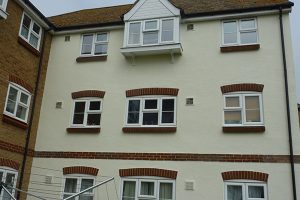Table of Content
Whether or not you need planning permission to remove pebbledash depends on various factors such as the location of the property, its size and height, and whether or not it is a listed building.
In general, if the property is in a conservation area or is a listed building, you may need planning permission to remove pebbledash. It is recommended to check with your local planning authority to determine if you need planning permission for this project.
What is pebbledash?
Pebbledash is a type of exterior wall coating made from small stones or pebbles mixed with a cement-based mortar. It is typically used to add texture and visual interest to the outside of buildings.
The pebbles are embedded in the mortar and spread evenly over the surface of the wall, creating a rough, bumpy surface. Pebbledash is a relatively inexpensive and low-maintenance finish that is often used for homes, offices, and other types of buildings.

Importance of planning permission
Planning permission is important to remove pebbledash because it is a requirement of the local government to ensure that any changes made to the exterior of a property comply with local building regulations and planning laws.
Without proper planning permission, the property owner may be in violation of the law and could face penalties or legal action. Additionally, if the property is sold in the future, the lack of planning permission could negatively impact its value or even render it unsellable.
Obtaining planning permission helps to ensure that the work being done is safe, meets local standards, and does not negatively impact the surrounding area or community.
Factors that determine if planning permission is needed
The factors that determine if planning permission is needed for removing pebbledash include:
- Location of the property: Planning permission may be required if the property is located in a conservation area or a listed building.
- Building regulations: The removal of pebbledash may require building regulations approval if it affects the structure or thermal elements of the building.
- Property usage: Planning permission may be needed if the property is used for commercial purposes or if it is a multi-residential building.
- Local council guidelines: Different local councils may have different planning guidelines, so it is important to check with the local authority to determine if planning permission is required.
- The extent of the work: The extent of the work, including the size of the area to be stripped and the materials to be used, may also affect the need for planning permission.
It is recommended to consult with the local council and a qualified builder before proceeding with any work to determine if planning permission is required.
Additionally, it’s worth noting that even if planning permission is not required, building regulations approval is still likely to be necessary for the removal of pebbledash. This is to ensure that the work complies with safety and health standards, as well as energy efficiency requirements.
In some cases, pebbledash may have been applied to the building as part of a previous renovation or extension, and its removal may affect the stability of the structure. In such instances, the local council may require a structural survey to be carried out before granting building regulations approval.
Furthermore, if the property is a listed building, it’s important to note that removing pebbledash may have an impact on its historical significance. Listed buildings are protected by law, and any alterations must be carried out in accordance with strict guidelines. In such cases, planning permission is likely to be required, and it may also be necessary to seek the advice of a conservation officer.

How to determine if planning permission is needed?
To determine if planning permission is needed to remove pebbledash from a building, it is important to follow the following steps:
- Check with local authorities – Contact the local council or building control department to inquire about the specific requirements for removing pebbledash in your area. They will be able to provide guidance on whether or not planning permission is required.
- Consult with a planning professional – You can also consult with a planning consultant, architect, or surveyor who has experience in this area. They can advise you on the planning regulations and the process of obtaining planning permission, if necessary.
- Review building regulations and guidelines – It is important to review the building regulations and guidelines to ensure that you are fully aware of the requirements and restrictions when it comes to removing pebbledash. This information can typically be found on the local council’s website or by contacting the building control department.
By following these steps, you can ensure that you are fully informed about the planning requirements for removing pebbledash and that you are in compliance with the relevant regulations and guidelines.
Alternatives to planning permission
If you wish to remove pebbledash from your property, there are several alternatives to obtaining planning permission:
- Permitted Development Rights: Check if the property falls under Permitted Development Rights, which allows for certain types of work to be carried out without the need for planning permission.
- Building Regulations Approval: Building regulations approval is required for the removal of pebbledash to ensure that the work is carried out to a safe and satisfactory standard.
- Conservation Area Consent: If the property is located in a conservation area, consent may be required from the local authority to carry out any works that affect its character or appearance.
- Listed Building Consent: If the property is a listed building, a listed building consent is required for any works that affect its character, appearance, or architectural significance.
It is important to note that these alternatives may still require formal approval from the local authority, so it is advisable to consult with them before proceeding with the removal of pebbledash.
Conclusion
Whether planning permission is required for removing pebbledash from a building depends on various factors, such as the location and age of the building, its status as a listed building, and local planning regulations.
Generally, planning permission may not be necessary for minor works, such as the removal of pebbledash, as long as they do not affect the building’s external appearance or alter its original design.
In conclusion, removing pebbledash from a building is a complex process that may require both planning permission and building regulations approval.
It’s always advisable to check with your local planning authority before proceeding with any work to determine if planning permission is needed.

